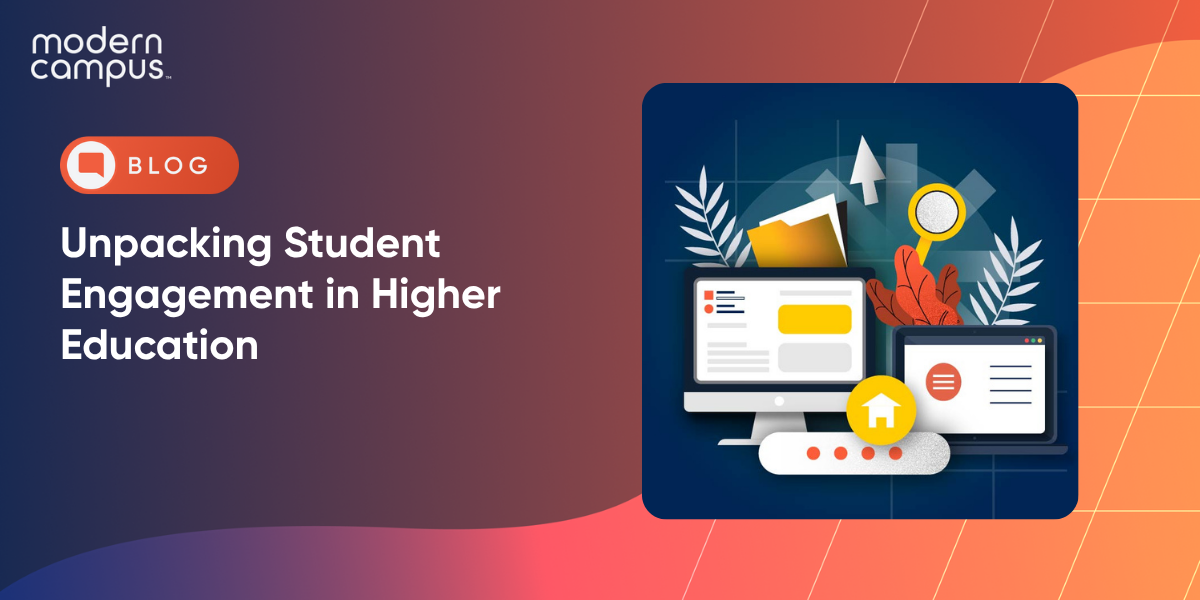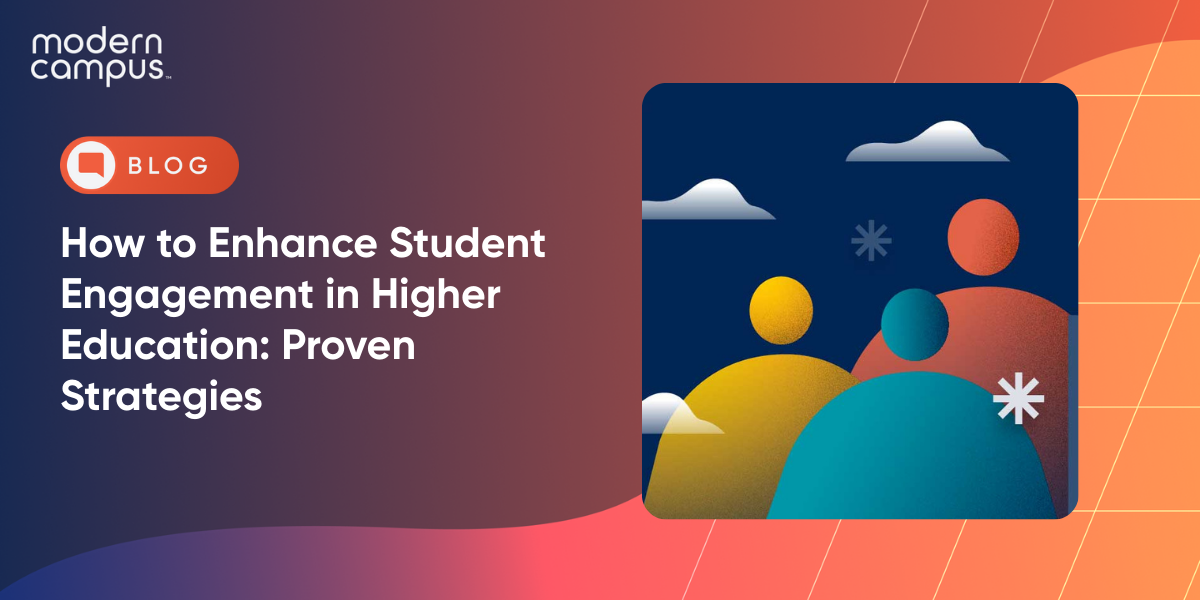Getting students to attend their classes is not enough to ensure their success. It’s also not enough for any college or university to achieve its mission. Students must be engaged emotionally, cognitively and behaviorally inside and outside the classroom. Such engagement is crucial to their academic performance, connection to the institution and development of workforce-ready skills.
The easiest way to enhance your overall engagement strategy is to adopt student engagement software for universities. These platforms help streamline communication, connect students with co-curricular opportunities and provide personalized engagement pathways that keep them involved throughout their academic journey, promoting student engagement at every touchpoint. By integrating real-time analytics and automated engagement tracking, institutions can measure student engagement effectively and tailor interventions to support student success.
The top benefits of student engagement in higher education include:
- Increased matriculation, retention, persistence and on-time graduation
- Increased GPA
- Increased sense of student belonging within the institution
- Increased level of satisfaction with the higher education experience
- Increased workforce readiness, as measured by the development of in-demand skills
- Increased chance of obtaining a job offer upon graduation
- Increased undergraduate student interest in attending graduate or professional school
See our free infographic for additional student engagement statistics.
We'll explore the three primary dimensions of student engagement, uncover the top factors that influence engagement, suggest best practices for measuring and assessing engagement, provide ideas for improving student engagement and explore future trends for boosting engagement
Dimensions of Student Engagement in Higher Education
A student's level of engagement can best be understood across three dimensions: cognitive, emotional and behavioral. These dimensions form the foundation of student engagement in higher education, influencing academic success, institutional loyalty and workforce readiness.

Cognitive
This dimension involves students' active participation in the learning process, challenging their preconceived notions, cultivating program-solving skills and promoting critical thinking.
Fostering cognitive engagement prepares students for the challenges they'll face outside of the classroom and beyond graduation.
Courses that stimulate cognitive engagement often incorporate interactive discussions, problem-solving activities and projects that encourage students to apply theoretical knowledge to real-world scenarios. Additionally, the integration of technology and collaborative learning platforms can enhance cognitive engagement by providing students with dynamic, immersive learning experiences.
Bloom's taxonomy provides a popular model for faculty and co-curricular program leaders to develop learning outcomes. Developed in 1956 by Benjamin Bloom with collaborators Max Englehart, Edward Furst, Walter Hill and David Krathwoh, the taxonomy is composed of six categories—each of which is progressively more challenging than the last as learners expand and deepen their learning:
- Remembering: recalling facts and basic concepts from recent or long-term memory
- Understanding: constructing meaning from oral, written and graphic messages
- Applying: using recalled information in novel situations
- Analyzing: drawing conclusions from ideas
- Evaluating: making judgments based on criteria and standards
- Creating: putting elements together to produce new work
Most first-time students will be used to the first category. Exams in their K-12 education test their recollection of information. It's then each institution's duty to challenge learners to engage with course content and co-curricular concepts on a deeper level—incorporating activities, exercises and experiences to move students across all six Bloom's taxonomy elements.
Emotional
This dimension involves students' emotional connection with their academic pursuits, peers and the overall campus environment. Feeling a sense of belonging, motivation and enthusiasm for learning are key indicators of emotional engagement.
Emotional engagement is key to any institution's educational mission and success, as a student who is emotionally engaged is far more likely to persist within their degree program and be retained by the institution.
Positive emotional engagement can compel a student to overcome academic barriers, leverage student support services and pursue ambitious goals by fostering intrinsic motivation that drives long-term commitment to learning and personal growth.
Behavioral
Behavioral engagement involves observable indicators of cognitive and emotional engagement.
Inside the classroom, a student who is highly engaged within this dimension will ask the instructor questions and assert their viewpoint during discussions. They may also take notes, lead group projects and volunteer to give presentations.
Behavioral engagement also expands outside of traditional course experiences. Active participation in extracurricular or co-curricular activities, service learning and community engagement are all essential components of behavioral engagement within modern higher education, allowing learners to collaborate with other students and build meaningful connections.
Factors Affecting Student Engagement
Increasing student engagement in higher education isn't as simple as tweaking one or two elements of the educational experience. Many factors contribute to student engagement, including teaching methods, institutional support and extracurricular opportunities. Institutions must take a holistic approach, addressing cognitive, emotional and behavioral factors to create a meaningful and lasting impact on student success.

Colleges and universities seeking to boost engagement must consider higher education from the following attributes.
Learning Process: Teaching Quality and Pedagogy
Incorporating interactive activities in both academic and co-curricular programs can enhance engagement, as can using a variety of instructional strategies to cater to different student learning styles.
Clear communication is also essential for capturing students' interest, and the instructor's passion for a subject can keep a student invested in the course.
Active Learning Opportunities to Hold Students' Attention
Active learning strategies—such as group discussions, case studies, presentations and hands-on research—can stimulate cognitive engagement, making classroom learning more interactive and impactful for students. When paired with student engagement software for universities, these strategies become even more effective by providing digital tools that facilitate collaboration and real-time feedback.
Moving beyond traditional lecture-based approaches allows instructors can create environments that empower students to actively participate in their learning processes, leading to a deeper understanding of course material through discussion and hands-on application.
Course Content and Relevance
Courses and co-curricular experiences that demonstrate real-world applicability and relevance to employer demands drive greater student engagement than lectures or discussions based on theoretical or outdated ideas.
Integrating interdisciplinary topics can also foster deeper engagement, as students can draw connections across themes addressed within multiple courses and fields.
Physical Learning Environment
The physical layout and atmosphere of the classroom environment, meeting space or event hall can impact how well students focus on the subject matter. Thoughtful design, accessibility considerations and technology integration all contribute to creating an engaging and effective learning space. Faculty and staff should work together to design spaces that are comfortable, well-lit and organized.
Accessibility services should also be consulted to ensure that all spaces are physically accessible and welcoming to students with physical, mental and learning disabilities.
Instructor-Student Relationships That Encourage Students
Students who have positive relationships with professors and support staff are more likely to ask questions, actively participate and contribute positively to their learning environments. Instructors should aim to be approachable, demonstrate genuine interest in students' success and provide timely, constructive feedback.
Meeting with students outside of the regularly scheduled learning experience can help foster positive relationships. This can involve faculty holding office hours and support staff—including academic advisors, career counselors, residence hall staff and Student Affairs leaders—joining students at campus events, attending student-run programs and leading field experiences.
Diversity, Equity and Inclusion
Emotional engagement thrives in a supportive and inclusive campus environment. School leaders shape policies and initiatives that foster inclusivity, ensuring that all students feel valued and motivated to engage.
Institutions should prioritize creating spaces where students feel heard, respected and valued—an essential aspect of educational leadership. To offer meaningful engagement opportunities, try establishing mentorship programs, providing mental health resources and promoting a culture of diversity and inclusion.
Technology Integration
Leveraging educational technology tools can make the higher education experience more dynamic and relevant for students of all ages and demographics.
For example, student engagement portals reduce barriers to co-curricular engagement by centralizing all resources into one shared hub. Communication tools, such as text messaging, allow students to communicate with students and explore opportunities on their own schedule.
Scheduling tools make it easier to build course schedules that fit around non-academic obligations and interests.
Provide Students with Support Services
Support services are pivotal in supporting cognitive, emotional and behavioral engagement. Tutoring services, writing centers and academic advising help students develop essential study skills and time management strategies.
Meanwhile, career counseling can motivate students to align their academic pursuits with their career aspirations. At the same time, orientation programs and ongoing opportunities like First-Year Experience and leadership programs help students build connections within the broader campus community.

Evaluation and Self-Reflection
Regular, timely and constructive feedback from faculty and staff helps students understand their progress and areas for improvement. Better yet, encouraging students to evaluate their own learning encourages deeper investment in the learning and skills development process. Ultimately, they gain a deeper understanding of how their academic journey connects to real-world applications.
By regularly encouraging students to self-reflect, institutions help them better articulate their skills to employers, understand the immense value of co-curricular learning and appreciate feedback from mentors and peers.
Personal Well-Being
A student's mental, emotional and physical health is intrinsically tied to their ability and willingness to engage with the opportunities around them. Physical and mental illnesses—along with stress, anxiety and depression—provide enormous barriers to student success.
Students who are unable to develop healthy coping mechanisms and leverage appropriate support systems will often fail to persist in their academic studies.
Financial Assurance
Worries about financial stability can harm engagement. A student who struggles to afford tuition, books, housing, living expenses and other personal costs may be unable to fully invest in their studies.
Additionally, needing to work part- or full-time may prevent some learners from joining student organizations and attending campus events.
How to Measure Student Engagement in Higher Education
If you want to increase engagement—across your entire student body or within certain student demographics—you need first to understand the existing trends, habits, behaviors and preferences related to engagement at your institution.
Many institutions have found the following methods helpful for measuring engagement.
Surveys and Questionnaires
National surveys like the National Survey of Student Engagement (NSSE) and the Community College Survey of Student Engagement (CCSSE) provide standardized measures of student engagement. Additionally, student engagement software for universities offers built-in analytics to track participation trends and engagement metrics in real time.
Institutions can create custom surveys to measure specific aspects of student engagement, focusing on areas like classroom experiences, extracurricular involvement and overall satisfaction.
Self-Reflection Forms and Exercises
Self-reflection forms and activities deepen student engagement, but they can also provide institutions with valuable assessment data through evidence of students' self-development and growing engagement. Encouraging students to regularly assess their own progress fosters self-regulation, helping them take ownership of their learning process. Additionally, structured reflection exercises can enhance students' attention to their academic and co-curricular experiences, leading to a more meaningful connection with their educational journey.
Focus Groups and Interviews
Focus groups and interviews can provide valuable qualitative data to complement quantitative measures. By speaking with students individually and within small groups, institutions can explore student experiences and perceptions in depth.
Anecdotes and insights from interviews and focus groups can form theses for later research that can be expanded to a wider sample.
Learning Analytics to Gauge Student Interests
Learning Management System (LMS) data can offer insights into how students engage with digital resources, participate in virtual discussion forums and complete online assignments. Relatedly, tracking digital engagement data can allow an institution to understand how frequently and for how long students interact with online materials.
In addition to understanding current student engagement, website analytics can also be valuable to admissions and alumni teams. Understanding how alumni and prospective students engage with the institution's website is key to making changes that better reflect the interests of an institution’s core audiences.
Attendance and Participation Records
Within the classroom, regularly monitoring attendance can offer a basic indicator of student engagement with course content. Student engagement software for universities streamlines this process by integrating attendance tracking with digital participation insights, helping educators better understand student involvement. Keeping records of student participation in class discussions, group activities and other interactive elements provides additional insights.
Coursework Performance
Analyzing student performance on exams, projects and assignments can offer insights into each learner's level of cognitive engagement, helping institutions identify trends that impact academic achievement and student success. Faculty should establish clear criteria and use rubrics to assess the depth and breadth of engagement.
Co-Curricular and Extra-Curricular Involvement
Assessment is critical to understanding student engagement within clubs and organizations, campus events, service-learning projects and other co-curricular opportunities that promote development outside of the classroom.
As we explored within The Student Affairs Guide to Data-Informed Decision-Making, co-curricular experiences can be measured through surveys, polls, interviews, focus groups and participation data.
Retention and Graduation Rates
The percentage of students who persist from one semester or academic year to the next may also be indicative of cognitive, emotional and behavioral engagement. Institutions struggling with low student engagement often see lower retention rates, making it essential to implement proactive strategies that foster deeper student connections. Similarly, institutions may find that high graduation rates correlate with positive student engagement, as graduation requires an advanced level of classroom success.
Strategies for Increasing Student Engagement
Every department, office, individual staff and faculty member can play a role in enhancing student engagement at their institutions. Here are some of the top strategies that should be implemented and considered.
Create a Sense of Community
Programs, initiatives and events overseen by Student Affairs provide extraneous fun, but they're also essential for transforming a sprawling institution into an inclusive community. How well an institution engages its students outside of the classroom can even make or break its retention rate.
Student engagement software for universities centralizes event management, tracks involvement and provides students with personalized recommendations for extracurricular opportunities.
Consider orientation programs that help students acclimate to the higher education experience. Other beneficial strategies include clubs and organizations promoting social interactions, community-building and leadership development and residential life initiatives that enhance students' connections with their peers.
Use Technology to Enhance Learning
Leveraging technology creates interactive and dynamic learning experiences, especially for Gen-Z and Millennial learners who expect technological integrations. Implementing student engagement software for universities ensures that institutions meet these expectations by offering seamless digital interactions and real-time engagement tracking.

Colleges and universities should consider introducing digital maps and virtual tours that simulate the campus experience for prospective learners, class schedule optimization tools to connect students with appropriate course schedules each term, conversational text messaging that's enhanced by AI to connect students with staff resources 24/7 and a student engagement portal to streamline, enhance and incentive involvement.
Institutions with non-traditional students and lifelong learning programs can benefit from management systems specifically designed for such learners.
Incorporate Real-World Applications
Linking academic and co-curricular concepts to real-world scenarios enhances the practical relevance of coursework and student leadership initiatives. These can often come in the form of high-impact practices (HIPs)—long-term experiences intentionally designed to foster student success.
These practices include internships and co-ops, industry partnerships, first-year seminars, living-learning communities, service projects, student abroad programs, capstone projects and field experiences.
In addition to driving student engagement, high-impact practices are also positively associated with increased GPA and retention, increases in critical thinking and writing skills and higher rates of student-faculty interaction.
Offer Support and Resources for Mental health and Well-Being
Investing in students' mental well-being is both a moral imperative and a strategy for ensuring the institution's own prosperity. Common stressors—including social isolation, academic pressure and financial stress can impede a student's ability to succeed inside the classroom and prevent them from engaging in co-curricular opportunities.
To help students cope with transitional challenges and improve their mental health, institutions should provide counseling and therapy services, empower students to leverage academic resources, increase access to financial aid and scholarships and promote a welcoming environment.
Mentoring Programs
Personalized guidance is a powerful tool for aiding students on their academic and personal journeys. Mentorship can come in the form of peer mentors, faculty or staff mentors who offer academic and career guidance and alumni mentors who offer keen career insights and life advice—all of which contribute to a student’s personal development and long-term success.
Real-World Examples of Boosting Student Engagement
Perhaps the best way to develop your own student engagement strategy is to study the successes of peer institutions. Here are some top success stories involving colleges and universities whose engagement initiatives have yielded impressive, rewarding results.
Engaging Prospective Students
- Central Oregon Community College more than tripled its engagement on its website by adding up-to-date occupational data related to each academic program.
- GEAR UP Kentucky engaged thousands of high school students and their parents in conversations about higher education through more than 105,000 text messages sent within a year.
- Ohio Wesleyan University increased engagement with its website by adding campus maps and virtual tours powered by Modern Campus. Prospective students spend more than double the amount of time exploring these pages on OWI's website than any other page.
Engaging Current Students
- Carl Sandburg College made course registration a smooth, engaging experience for students by adding intuitive search elements, simplifying digital navigation and offering interactive features within its course catalog.
- College for Creative Studies engaged hundreds of previously unengaged students in co-curricular life while quadrupling its number of student clubs and organizations. Implementing a branded, centralized engagement hub powered by Modern Campus Involve was key.
- Brigham Young University expanded and deepened engagement in peer mentorship by connecting mentors and mentees together via two-way conversational text messaging.
- Valdosta State University exceeded its highly ambitious goal of co-curricular event attendance by 109 percent. What's more, the university discovered that 95 percent of highly engaged students persisted to the next semester—a retention rate that's 13 percentage points higher than their unengaged peers.
Engaging Alumni
- Virginia Commonwealth University engaged more than 35,000 alumni via text messaging powered by Modern Campus Message.
- The University of Notre Dame increased alumni engagement by designing custom text messaging campaigns. Doing so has also boosted alumni giving, particularly among students who graduated within the past five years.
- North Carolina State University nearly doubled donations on its annual day of giving simply by texting alumni and leveraging gamification strategies.
Future Trends in Student Engagement
Predicting future trends in student engagement is challenging, as it depends on evolving industry landscapes, technological advancements and societal shifts. However, several emerging trends suggest how colleges and universities might engage students both inside and outside the classroom in the near future.
Personalized Learning Experiences
More institutions will leverage physical and digital technologies to create adaptive learning environments that cater to individual student needs and preferences. A customized curriculum will allow students to design unique learning pathways based on their interests, career goals and learning styles.
Virtual and Augmented Reality
A future in which VR is a regular part of higher ed life isn't too far off! Using virtual and augmented reality to provide immersive, interactive educational experiences will engage students in fresh, exciting ways. Such tech can also be used to attract prospective students to apply or enroll via virtual tours, orientations and fairs.
Gamification
Gamification is already a popular, proven strategy for incentivizing students to engage with experiences outside of the classroom. Faculty and academic leaders can follow suit by integrating gamified elements into individual coursework and career pathways. Institutions can fuse academic and co-curricular experiences by rewarding student achievements with digital badges and providing rewards for completed milestones.
Hybrid Learning
As the Chronicle for Higher Education found, students love the flexibility offered by hybrid learning models and are keeping the demand high. Institutions looking to get ahead in the engagement game should expand their offering of programs that combine online and in-person instruction while investing in new ways to deepen the impact of such programs and reach students through personalized engagement strategies.
Leveraging technology-driven strategies can transform student engagement in higher education, making learning more accessible, flexible and tailored to individual student needs.
Data-Driven Student Support
In addition to using data to boast about engagement gains, institutions will use predictive analytics to identify students at risk of disengagement. Early warning systems will prompt the right institutional staff and faculty to intervene and support students in real time.
Social Media Integration
Students, especially Gen-Z, are already checking their social media feeds throughout the day. Why not use that to your advantage?
Institutions can leverage popular and emerging social media platforms for educational purposes, collaborating with influencers and educators to create informative, engaging content. Social media can even be used to offer virtual study groups, academic support communities and mentorship programs.
Continuous Professional Development for Faculty and Staff
To ensure that instructors can properly leverage emerging technology, institutions should provide faculty and staff with ongoing training. Such training should cover inclusive teaching methods, culturally responsive education and technology usage.
Investing in Engagement: The Key to Student and Institutional Success
Student engagement is the foundation of student success and institutional growth. When colleges and universities fail to create meaningful connections with their students, they struggle with enrollment, retention and long-term alumni support. But when engagement is a priority, students feel more connected, persist through challenges and graduate ready to thrive.
At the end of the day, engagement is everyone’s job. Faculty, staff and administrators all play a role in fostering an environment where students feel supported, motivated and involved. And when we get it right, the benefits extend far beyond the classroom—helping students build lifelong relationships with their peers, institution and future careers.
At Modern Campus, we’re committed to helping institutions like yours create personalized, dynamic engagement experiences that keep students involved from day one through graduation and beyond. Request a demo to start transforming student engagement at your institution.




